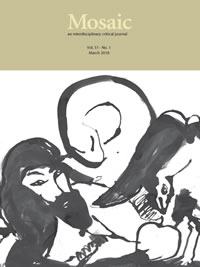Issue 51.1
Overview

General Issue
Published: March 2018
View the issue introduction or see the issue summary and contents below.
12 essays, totalling 224 pages
$29.95 CAD
The topography of the general issue is always rough and unpredictable. As the poet Trevor Joyce would put it, the granularity of every essay is different. The terrain is uneven, the content variable, and on the micro level all mapping gives way to terra incognita. Every general issue also has its high point: here especially the pages Joseph P. Vincenzo devotes to Nietzsche’s environmental aesthetics. In the present issue we have called upon “Zarathustra’s Animals” to introduce the fundamental problem, to perform a certain work, and to showcase and model a kind of relation to what Vincenzo isolates in Nietzsche’s texts as the “sensible particular (aisthētón),” “small things,” the “little that makes the best happiness.”
Zarathustra’s Animals: Lessons in Environmental AestheticsJoseph P. Vincenzo By way of an examination of what Nietzsche’s Zarathustra learns from his animal companions, this essay argues that the fundamental thought of Thus Spoke Zarathustra, the thought of eternal recurrence, cultivates an aesthetic appreciation of the natural environment; hence, Nietzsche’s contribution to the field of environmental aesthetics. | |
Blow the Bugles over the Metaphysicians: Louis MacNeice and an Aesthetics of ErrorAhren Warner This essay explores the Lacanian concept of “constitutive error” as analogous to a MacNeician “poetics of error.” Contrary to critical consensus, I examine the extent to which the philosophy of Louis MacNeice’s poetry might be considered radically cogent, as well as the extent to which it might spur a rereading of Lacanian aesthetics. | |
Material Matters in Digital Representation: Tree of Codes as a Literature of DisembodimentLai-Tze Fan In a digital era of representation, where screen content is abstracted from material objects/apparatuses, how do we still associate “text” and “book” with materiality? This essay analyzes Jonathan Safran Foer’s Tree of Codes as a “literature of disembodiment”—experimental print texts that represent objects from which materiality is erased. | |
Strategic Alterations and Afro-Asian Connections in Paul Beatty’s TuffSami Schalk This essay argues that Paul Beatty’s Tuff does not simply employ or reverse stereotypes, but rather uses Afro-Asian connections to strategically alter stereotypes of urban black masculinity. In doing so, Beatty demonstrates the potential influences of polyculturalism on racial identification and affiliations. | |
An Equation of Collectivity: We + You in Richard Wright’s 12 Million Black VoicesMehdi Ghasemi I approach Richard Wright’s 12 Million Black Voices as a documentary fiction to show how Wright first depicts the “we” vs. “you” dichotomy between white and African Americans but then invites both to leave behind the “we” vs. “you” and embrace a “we + you.” | |
What is or was Postmodern Fiction? Murakami after BorgesNina Pelikan Straus If Haruki Murakami’s fictions are symptomatic of what has happened to the (Jamesian) notion of a “central intelligence” as necessary to the novel, they present a new level of postmodernist “blank pastiche” and require new reading habits. While Jorge Luis Borges’s characters often offer literary/philosophical explanations of postmodernity’s break with the traditional reader’s narrative expectations, Murakami succeeds in cyber-spacing and de-centralizing human consciousness. Readers are learning to surf. | |
Dotted Lines and Fountain Diagrams in Descartes’s Treatise on ManLaura C. Balladur Adding to a body of work that revisits the outdated idea of Cartesian dualism, this close reading of illustrations and the fountain automata in René Descartes’s Treatise on Man shows that whether early modern or contemporary metaphors, we still use similar diagrams to describe identity. | |
Lost Time and the Heterotopic Image in W.G. Sebald’s AusterlitzKatie Fry W.G. Sebald’s treatment of time, remembrance, and photography in Austerlitz recalls Marcel Proust’s theory of involuntary memory and Walter Benjamin’s philosophy of history yet lacks their redemptive thrust. This essay considers Austerlitz’s divergence from the theories of Proust and Benjamin, and employs Michel Foucault’s notion of heterotopia to elucidate the book’s irreconcilably fragmented depiction of time. | |
Ghostwriting Abigail: The Haunting Authorship of Chris Abani and Dave EggersLeif Schenstead-Harris Prose fictions such as Chris Abani’s Becoming Abigail and Dave Eggers’s What Is the What mobilize their readers’ readiness to identify with a given protagonist through differently haunted styles of fictional presentation. This essay explores how Eggers and Abani either embrace or refuse the ambiguous lies and troubled authenticity of ghostwriting. | |
Walking in Colour: Another Look at Musical Ekphrasis through Marc Chagall’s Jerusalem WindowsThomas C. Connolly “Musical ekphrasis” was recently coined as a creative and critical figure to describe compositions that represent a work of art conceived in another medium. It has since enjoyed little resonance. This essay reassesses the validity and potential of musical ekphrasis, examining a composition by Jacob Gilboa that recreates Marc Chagall’s Jerusalem Windows. | |
Plato, New Media Technologies, and the Contemporary NovelMargaret-Anne Hutton In a world of new media and rapid technological change the nature and status of representation—both aesthetic and political—evolve. Is this why we are experiencing a soul-searching “Platonic turn”? Contemporary works of fiction by José Saramago, Peter Ackroyd, and Dave Eggers rework the cave and mirror analogies of The Republic. | |
The Trial of Paul GauguinDidier Maleuvre The painter Paul Gauguin has been the object of criticism linking him to the sins of colonial occupation and European imperialism. This essay examines the case against Gauguin. It asks the reader to examine closely the assumption that representation is necessarily a form of appropriation. The larger aim is to establish a more careful idea of the moral relation between art, especially modernist art, and reality. |